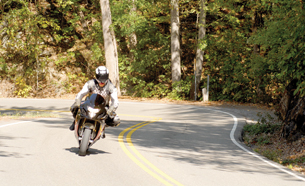Module 1
1. Module 1
1.3. Lesson 1
Module 1—Momentum and Impulse
Lesson 1—Momentum and Newton’s Second Law
 Get Focused
Get Focused

© David P. Smith/shutterstock
The motorcycle has been popular for a long time. Driving a motorcycle has been compared to riding a horse because the rider is completely exposed to the elements. It’s also like flying a small aircraft because it’s “a full-body experience.” It requires a feel for the road—leaning into turns and constantly making adjustments for changing road conditions.
There is, however, very little protection for the rider if a crash occurs. Consider the typical motorcycle fatality in Canada. It seems to have a common profile—single vehicle, summer weekend evening, rural road with a posted speed limit over 90 km/h. Motorcycle fatalities in Alberta more than doubled between 2000 (14 fatalities) and 2006 (32). Sadly, the annual number of motorcycle driver deaths is on the increase. Statistics indicate that one contributing factor is the increasing number of very powerful, high-performance motorcycles. Compare the two bikes pictured here.

© John Neff/shutterstock (speeder on highway)
© ann trilling/shutterstock (woman on bike)
The death rate for people riding high-performance motorcycles is about three times that of people riding lower-powered machines. Why do you think that is? Could the phrase “speed kills” apply here?
Part of the answer to this question involves exploring the concept of momentum and how it is related to the vector quantity velocity and the scalar quantity mass.
In this lesson you will answer the following essential questions:
- What is momentum?
- Why is momentum defined as a vector?
- How is momentum related to Newton’s laws?
 Module 1: Lesson 1 Assignment
Module 1: Lesson 1 Assignment
Your teacher-marked Module 1: Lesson 1 Assignment requires you to submit responses to the following:
- Assignment—A 1, A 2, A 3, A 4
- Discuss—D 1, or D 2, or D 3
- Reflect on the Big Picture
The other questions in this lesson are not marked by the teacher; however, you should still answer these questions. The Self-Check and Try This questions are placed in this lesson to help you review important information and build key concepts that may be applied in future lessons.
After a discussion with your teacher, you must decide what to do with the questions that are not part of your assignment. For example, you may decide to submit to your teacher the responses to Try This questions that are not marked. You should record the answers to all questions in this lesson and place those answers in your course folder.